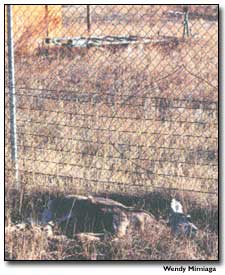|
December 6, 2001
By Janelle Holden After nearly five years, the Montelores Habitat Partner-ship Program remains a little-known funding source for landowners. Initiated by the state, the program helps property owners reduce damage caused by wildlife and funds wildlife-habitat improvement projects with funds from a percentage of deer and elk hunting-license fees. "The overarching theme is reducing conflicts, reducing damage," said Carla Harper, the programís secretary. "If youíve got an animal caught in your fence, itís a conflict and itís damage, even if itís a small acreage. "Ideally I think HPP was set up to deal with bigger issues and problems, but the parameters are flexible enough that it can include a whole lot of different types of landowners and types of problems." Since its inception in 1997, the committee has funded $160,000 in projects. And more landowners may be eligible for funding now that the committee has changed a rule that excluded any landowner from the program if he or she charged hunters more than $100 per gun or would not allow hunting on the property. "Itíll be on a case-by-case basis," said Harper. Building wildlife-friendly fences is one of the most common funding requests. According to a Colorado Division of Wildlife handbook, poor fencing can kill deer and elk and alter established wildlife-migration routes. The DOW recommends keeping fences under 42 inches with at least 12 inches of space between the top two wires. Also, vinyl-coated wire on the top wire helps elk and deer judge the distance they need to jump and reduces damage to existing fences. Interested landowners can apply to HPP for a $200 fencing-material voucher from a local supply store. A maximum of three vouchers a year are given out. The committee also helps landowners build ponds, fertilize, seed native grasses for wildlife habitat, and conduct prescribed burns. Included on the committee for Montezuma and Dolores counties are representatives of the livestock industry, sport-hunting community, landowners, Division of Wildlife, U.S. Forest Service/BLM, and Natural Resources Conserva-tion Service. Keeping enough food and forage on public land is another facet of the program. Currently, the HPP committee is considering an experimental grazing program on 4,500 acres of U.S. Forest Service land in the Sage Hen, May Canyon, and Lone Dome areas. "Basically what weíre going to do is experiment with holistic management and rotational grazing," explained Harper. "Those areas, the Lone Dome and the Sage Hen, were set aside with the McPhee Project for wildlife, so there hasnít been any grazing there for many years. "Whatís happened is the grasses have become decadent, and itís just not palatable; itís not healthy, and wild animals donít want to use it." Harper explained that grazing would occur only for short periods in the areas. "It would create a breather for some other (grazing) allotments, but this would not be an allotment," said Harper. "Itís very temporary and experimental." The project is slated for 2003 if it goes through. Harper said the project must meet the guidelines of the National Environmental Policy Act, and the committee will likely hire a private consultant to begin the NEPA work in the new year. For more information about funding a project, or a copy of the Montelores HPP Big Game Distribution Management Plan, call 565-6061 or attend the next HPP meeting on Tuesday, Dec. 11, at the Montezuma County Court-house in the commissionerís room from 6 to 8 p.m. A project to seed Kernan Canyon, BLM land near Mancos, was tabled at the last meeting. The committee is planning to hold onto the proposal until later in the year and requested the BLM contribute a matching amount of $10,000 to the project.
|
||
|
Copyright © 2001 the Cortez
Journal. All rights reserved. |
